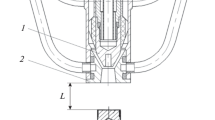The use of plasma-based technologies elevates productivity and product quality in the fabrication of welded structures made of aluminum and its alloys. High-power heat sources must be used to achieve high levels of productivity in the welding of aluminum structures. Also, the presence of an oxide fi lm that impedes the formation of the weld dictates the use of reverse-polarity current in the arc welding of such structures. The use of combination heat sources can resolve the problem of improving quality and productivity in the welding of aluminum alloys. This article presents results from a study of the plasma welding of aluminum alloys with the use of a dual-arc plasmotron that provides for the combustion of two direct arcs on reversepolarity current. It is shown that the plasmotron can operate stably under these conditions. Use of the given technology reduces the thermal load on the plasmotron, enhances its ability to melt through the alloys, improves cathodic cleaning of the metal’s surface in the region of the weld, and ensures the formation of welds that are free of defects.


Similar content being viewed by others
References
V. A. Nikolaev, I. N. Fridlyander, and Yu. P. Arbuzov, Weldable Aluminum Alloys, Metallurgiya, Moscow (1990).
M. P. Orlov, N. V. Shiganov, E. N. Kuznetsov, et al., “Plasma-arc welding of aluminum alloys without forming blocks,” Svar. Proizv., No. 11, 23–24 (1975).
H. G. Martinez, R. E. Marques, J. C. Mecture, and A. C. Nunes, “Front side keyhole detection in aluminum alloys,” Weld. J., No. 5, 49–52 (1992).
Yu. D. Shchitsyn, V. Yu. Shchitsyn, H. Harold, and W. Weingart, “Plasma welding of aluminum alloys,” Svar. Proizv., No. 5, 36–42 (2003).
E. M. Esibyan, Plasma-Arc Unit, Tekhnika, Kiev (1971).
Yu. D. Shchitsyn and O. A. Kosolapov, “Effect of polarity on the thermal loads on a plasmotron,” Svar. Proizv., No. 3, 23–25 (1997).
V. Yu. Shchitsyn and V. M. Yazovskikh, “Effect of polarity on heat transfer to the nozzle of a plasmotron,” Svar. Proizv., No. 1, 17–19 (2002).
“Plasma – MJG boots tank trailer output,” Weld. Design Fabric., 56, No. 2, 54–55, 59 (1983).
Yu. D. Shchitsyn and Yu. M. Tytkin, “Plasma welding of aluminum alloys with a fl oating electrode,” Svar. Proizv., No. 5, 1–2 (1986).
A. V. Redchits and V. V. Ovchinnikov, “Improving the energy efficiency of plasma welding,” Svar. Proizv., No. 8, 21–23 (2004).
Author information
Authors and Affiliations
Corresponding author
Additional information
Translated from Metallurg, No. 12, pp. 79–81, December, 2015.
Rights and permissions
About this article
Cite this article
Shchitsyn, Y.D., Belinin, D.S., Shchitsyn, V.Y. et al. Plasma Welding of Aluminum Alloys with the Use of Two Direct ARCS on Reverse-Polarity Current. Metallurgist 59, 1234–1237 (2016). https://doi.org/10.1007/s11015-016-0243-5
Received:
Published:
Issue Date:
DOI: https://doi.org/10.1007/s11015-016-0243-5




